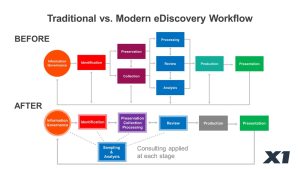 Proportionality is now the hottest legal issue involving eDiscovery, with the largest number of eDiscovery-related cases in the past year addressing the subject. Relativity eDiscovery attorney David Horrigan recently led an informative webinar “Data Discovery 2022 Mid-Year Update” (access recording here) reporting that 642 published court decisions tackled legal considerations involving proportionality in discovery in the first half of 2022. As only a very small number of cases involve a published decision that we can access online, it is safe to assume that several thousand more cases litigated the proportionality issue during this time period.
Proportionality is now the hottest legal issue involving eDiscovery, with the largest number of eDiscovery-related cases in the past year addressing the subject. Relativity eDiscovery attorney David Horrigan recently led an informative webinar “Data Discovery 2022 Mid-Year Update” (access recording here) reporting that 642 published court decisions tackled legal considerations involving proportionality in discovery in the first half of 2022. As only a very small number of cases involve a published decision that we can access online, it is safe to assume that several thousand more cases litigated the proportionality issue during this time period.
Proportionality-based eDiscovery is a goal that all judges and corporate attorneys want to attain. Under Federal Rule of Civil Procedure 26(b)(1), parties may discover any non-privileged material that is relevant to any party’s claim or defense and proportional to the needs of the case. Lawyers that take full advantage of the proportionality rule can greatly reduce cost, time and risk associated with otherwise inefficient eDiscovery.
While there is keen awareness of proportionality in the legal community, attaining the benefits requires the ability to operationalize workflows as far upstream in the eDiscovery process as possible. For instance, when you’re engaging in data over-collection, which in turn runs up of a lot of human time and processing costs, the ship has largely sailed before you are able to perform early case assessments and data relevancy analysis, as much of the discovery costs have already been incurred at that point. The case law and the Federal Rules provide that the duty to preserve only applies to potentially relevant information, but unless you have the right operational processes in place, you’re losing out on the ability to attain the benefits of proportionality.
An example of a process that effectively applies proportionality on an operational basis would be an iterative exercise to identify relevant custodians, their data sources, applicable data ranges, file types and agreed upon keywords, following the process outlined in McMaster v. Kohl’s Dep’t Stores, Inc., No. 18-13875 (E.D. Mich. July 24, 2020), and Raine Group v. Reign Capital, (S.D.N.Y. Feb. 22, 2022), and collect only the data that is responsive to such specific criterion. Both McMaster and Raine Group decisions apply proportionality at the point of identification and collection, not just production. The latest enterprise collection tech from Relativity and X1 enable such detailed and proportional criteria to be applied in-place, at the point of collection. This reduces the data volume funnel by as much as 98 percent from over-collection models, yet with increased transparency and compliance. In other words, a collection process that is targeted, automated and proportional, instead of one that is overbroad and manual.
However, traditional eDiscovery services typically involve manual collection, followed by manual on-premise hardware-based processing, and finally manual upload to review. These inefficiencies extend projects by often weeks while dramatically increasing cost and risk with purposeful data over-collection and many manual data handoffs. However, the first half of the EDRM involving collection and processing are now far more automated than they were even a few years ago. The purchasers of eDiscovery services and software have clearly noticed and are demanding adaptation from vendors, especially service providers. This new normal of proportionality focus presents a very significant challenge to many service providers.
So how can services firms adapt to this new paradigm? Here are few strategies:
First, services firms should move upstream to focus on information governance to reduce the data funnel as soon as possible. The new generation of eDiscovery technology in the areas of collection, identification, analytics and early data assessment, enables enterprises to operationalize proportionality principles. However, this ideally involves high-end strategic consulting to bring these processes together and operationalize them. This also enables services firms to develop direct and ongoing relationships with corporate law departments, IT and other key corporate stakeholders.
Second, service providers should pivot to managed services (like most other IT consultants) instead of a reactive project-based mindset. Fire drill eDiscovery projects by definition lack any process and result in data-overcollection and many other inefficiencies that thwart the realization of proportionality principles. Establishing a managed service relationship “bakes in” the service provider into an established eDiscovery workflow, including information governance, pre-collection analytics, targeted collection and integrated processing and hosting to enable far more proportional eDiscovery efforts, across multiple matters per client.
Third, services firms should find ways to develop or otherwise acquire their own differentiating tech or establish meaningful partnerships with tech platform providers. These partnerships should entail more than merely using the software, but the development of proprietary workflows or even technical integrations that enable unique service offerings that operationalize proportionality.
At the end of the day, eDiscovery is a technical process that is subject to technology disruption just like any other technology-based services industry. eDiscovery services firms that not only adapt to but embrace this change as a strategic opportunity will be the ones who prosper the most.
